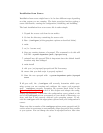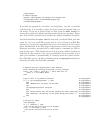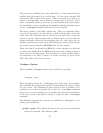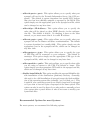—enable-test This turns on a test driver that is used only for debugging.
By default it is disabled.
—enable-nis Turns on the Network Information Server (NIS) code within
apcupsd. This is enabled by default. If you do not want to access the
status of the UPS from the network and you are not controlling any
slaves via NIS (enable-net), this can be disabled.
—enable-pthreads This option enables pthreads support causing
apcupsd to be built as a threaded program rather than forking to
create separate processes. apcupsd built in this fashion is more effi-
cient that the standard version being one third the data size and less
overhead locking and coping shared memory. This option is highly
recommended for Windows builds.
—with-libwrap=<path> This option when enabled causes apcupsd to
be built with the TCP WRAPPER library for enhanced security. In
most cases, the <path> is optional since configure will determine
where the libraries are on most systems.
—with-nologin=<path> This option allows you to specify where
apcupsd will create the nologin file when logins are prohibited. The
default is /etc
—with-pid-dir=<path> This option allows you to specify where
apcupsd will create the process id (PID) file to prevent multiple copies
from running. The default is system dependent but usually /var/run.
—with-log-dir=<path> This option allows you to specify where
apcupsd will create the EVENTS and STATUS log files. The default is
/etc/apcupsd. This option simply sets the default of the appropriate
path in the apcupsd.conf file, which can be changed at any later time.
—with-lock-dir=<path> This option allows you to specify where
apcupsd will create the serial port lock file. The default is systemde-
pendent but usually /var/lock. This option simply sets the appropriate
path in the apcupsd.conf file, which can be changed at any later time.
—with-pwrfail-dir=<path> This option allows you to specify where
apcupsd will create the powerfail file when a power failure occurs.
The default is system dependent but usually /etc.
—with-serial-dev=<device-name> This option allows you to specify
where apcupsd will look for the serial device that talks to the UPS.
The default is system dependent, but often /dev/ttyS0. This option
simply sets the appropriate device name in the apcupsd.conf file, which
can be changed at any later time.
37


















